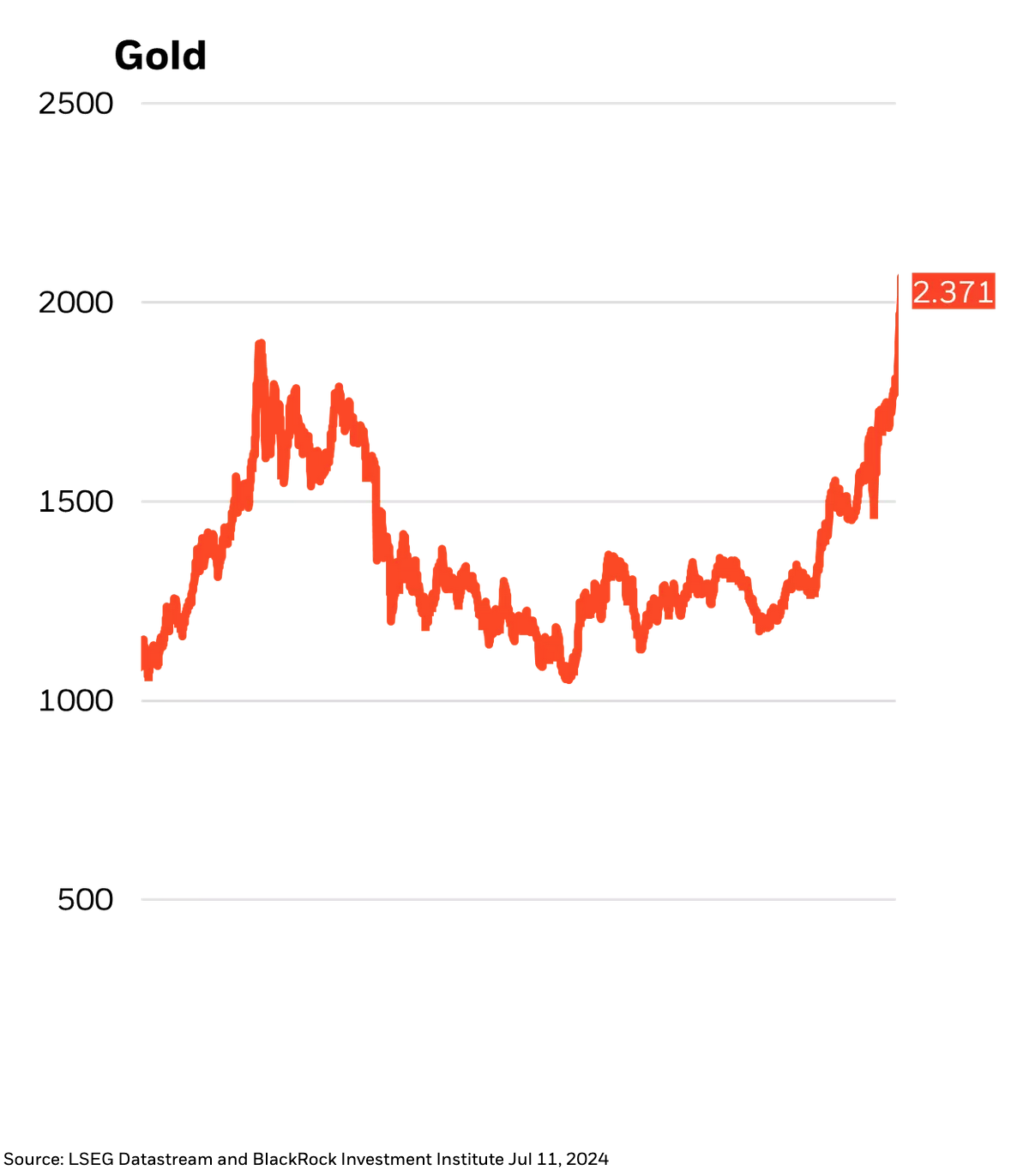by Russ Koesterich, CFA, JD, Portfolio Manager, BlackRock
In this article, Russ Koesterich discusses factors behind gold’s impressive performance year to date.
Key takeaways
- Gold’s performance YTD is in line with U.S. large cap equities. This strength is surprising given elevated interest rates and the U.S. Dollar, which historically has been a headwind for the metal.
- Going forward, the price of gold may continue to have support given increased demand from central banks and investors in the face of large, and increasing, U.S. fiscal debt levels.
Gold is having a very good year. Following the release of the June inflation report, via the consumer price index (CPI), the price of gold surged 2%, pushing year-to-date gains to 17%. (see Chart 1). Recent gains put gold’s performance on par with U.S. large cap equities. With government bonds roughly flat over the period, gold is easily outperforming a traditional 60/40 portfolio.
 Gold’s rally is more impressive when you consider that most traditional economic drivers, notably interest rates and the dollar, should be acting as headwinds. In other words, given a higher dollar and interest rates, you would have expected the price of gold to be down, not surging higher. Instead, investors have been ignoring moves in the rate markets and instead have been focusing on central bank buying along with record levels of government debt, both of which support an exposure to gold.
Gold’s rally is more impressive when you consider that most traditional economic drivers, notably interest rates and the dollar, should be acting as headwinds. In other words, given a higher dollar and interest rates, you would have expected the price of gold to be down, not surging higher. Instead, investors have been ignoring moves in the rate markets and instead have been focusing on central bank buying along with record levels of government debt, both of which support an exposure to gold.
Traditional relationships breaking down
I admit that I’ve been surprised, i.e. wrong about gold in 2024. While gold has benefited in recent weeks from the pullback in real interest rates, for most of the year real-rates had been grinding higher. Historically, this would have put downward pressure on gold.
The negative relationship between real rates and gold has a long pedigree. Looking at 20 years of quarterly data, changes in 10-year yields have a strong negative correlation (-0.64) with changes in gold prices (i.e. as yields have increased, the price of gold has decreased and vice versa). A similar dynamic holds for gold and the dollar. The dollar continues to defy expectations and has risen year-to-date. In the past, that would have also been associated with lower gold prices.
Watch the central banks
If not rates and the dollar, what accounts for the recent surge in gold? One catalyst has been a significant pickup in central bank buying. Based on data from Bloomberg, annual central bank precious metal purchases have quadrupled since 2020. The increase has been particularly acute for China, where gold on the central bank’s balance sheet has risen sharply since early 2023.
Outside of central banks diversifying their holdings, investors appear to also be taking note of increasingly unsustainable government budget deficits, mostly but limited to the United States. U.S. deficits appear stuck at 6-7% of gross domestic product (GDP) for the foreseeable future. Structural deficits, coupled with record pandemic stimulus efforts, have pushed gross public debt (which includes debt held by the Federal Reserve) near $35 trillion, more than 120% of GDP and a level last seen in the aftermath of WW II.
Going forward, investors may need to rethink the role of gold in a multi-asset portfolio. As the past year has demonstrated, gold may have support even in the face of elevated real rates and the near-term inflation outlook. Instead, gold appears to be evolving into a play on how central banks hold their reserves as well as a proxy for investor angst on when, if and how the U.S. address its debt problems.
Copyright © BlackRock














